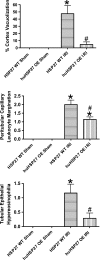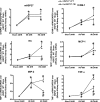Human heat shock protein 27-overexpressing mice are protected against acute kidney injury after hepatic ischemia and reperfusion
- PMID: 19656912
- PMCID: PMC2775579
- DOI: 10.1152/ajprenal.00317.2009
Human heat shock protein 27-overexpressing mice are protected against acute kidney injury after hepatic ischemia and reperfusion
Abstract
Liver ischemia-reperfusion injury (IRI) causes acute kidney injury (AKI) in mice characterized by renal endothelial cell apoptosis, renal tubular necrosis, inflammation, and filamentous (F)-actin disruption. Since heat shock protein 27 (HSP27) protects against apoptosis, necrosis, and stabilizes F-actin, we questioned whether overexpression of human HSP27 (huHSP27 OE) in mice would attenuate AKI after liver IRI. Twenty-four hours after hepatic IRI, HSP27 wild-type (WT) mice developed acute liver and kidney injury with elevated plasma alanine aminotransferase and creatinine, a reduced glomerular filtration rate, and histological evidence of renal endothelial cell apoptosis and tubular injury (necrosis, vacuolization, and F-actin disruption). The huHSP27 OE mice, however, were significantly protected against both liver and kidney injury after hepatic IRI. The huHSP27 OE mice also showed less induction of several proinflammatory mRNAs (TNF-alpha, MIP-2, and keratinocyte-derived cytokine), neutrophil infiltration, and reduction in apoptosis (terminal deoxynucleotidyl transferase biotin-dUTP nick end-labeling assay and DNA laddering) in the kidney compared with the HSP27 WT mice. Moreover, the huHSP27 OE mice showed significantly less disruption of F-actin in renal proximal tubules and better preserved vascular endothelial cell integrity compared with the huHSP27 OE mice. Finally, the kidney plays a major role in the hepatoprotective effects of huHSP27 overexpression as the hepatoprotection was reduced or abolished in mice subjected to unilateral or bilateral nephrectomy, respectively. Our results show that overexpression of huHSP27 protects against hepatic injury and AKI associated with liver IRI in vivo. Harnessing the mechanisms of cytoprotection with renal HSP27 may lead to new therapies for the perioperative AKI and liver injury associated with liver IRI.
Figures









Similar articles
-
Human heat shock protein 27 overexpressing mice are protected against hepatic ischemia and reperfusion injury.Transplantation. 2009 May 27;87(10):1478-87. doi: 10.1097/TP.0b013e3181a3c691. Transplantation. 2009. PMID: 19461484 Free PMC article.
-
Selective intrarenal human A1 adenosine receptor overexpression reduces acute liver and kidney injury after hepatic ischemia reperfusion in mice.Lab Invest. 2010 Mar;90(3):476-95. doi: 10.1038/labinvest.2009.143. Epub 2010 Jan 11. Lab Invest. 2010. PMID: 20065944
-
Selective renal overexpression of human heat shock protein 27 reduces renal ischemia-reperfusion injury in mice.Am J Physiol Renal Physiol. 2010 Aug;299(2):F347-58. doi: 10.1152/ajprenal.00194.2010. Epub 2010 May 19. Am J Physiol Renal Physiol. 2010. PMID: 20484296 Free PMC article.
-
Adenosine and protection from acute kidney injury.Curr Opin Nephrol Hypertens. 2012 Jan;21(1):24-32. doi: 10.1097/MNH.0b013e32834d2ec9. Curr Opin Nephrol Hypertens. 2012. PMID: 22080856 Free PMC article. Review.
-
Role of Mitochondrial Therapy for Ischemic-Reperfusion Injury and Acute Kidney Injury.Nephron. 2022;146(3):253-258. doi: 10.1159/000520698. Epub 2021 Dec 9. Nephron. 2022. PMID: 34883481 Free PMC article. Review.
Cited by
-
Small Heat Shock Protein Beta-1 (HSPB1) Is Upregulated and Regulates Autophagy and Apoptosis of Renal Tubular Cells in Acute Kidney Injury.PLoS One. 2015 May 11;10(5):e0126229. doi: 10.1371/journal.pone.0126229. eCollection 2015. PLoS One. 2015. PMID: 25962073 Free PMC article.
-
Nitrolipids in kidney physiology and disease.Nitric Oxide. 2018 Mar 29:S1089-8603(18)30006-5. doi: 10.1016/j.niox.2018.03.021. Online ahead of print. Nitric Oxide. 2018. PMID: 29605557 Free PMC article. Review.
-
Phosphorylated Heat Shock Protein 27 Inhibits Lipopolysaccharide-Induced Inflammation in Thp1 Cells by Promoting TLR4 Endocytosis, Ubiquitination, and Degradation.Inflammation. 2019 Oct;42(5):1788-1799. doi: 10.1007/s10753-019-01041-x. Inflammation. 2019. PMID: 31201585
-
Divergent roles for kidney proximal tubule and granulocyte PAD4 in ischemic AKI.Am J Physiol Renal Physiol. 2018 May 1;314(5):F809-F819. doi: 10.1152/ajprenal.00569.2017. Epub 2018 Jan 3. Am J Physiol Renal Physiol. 2018. PMID: 29357426 Free PMC article.
-
Impact of Mitochondrial Permeability on Endothelial Cell Immunogenicity in Transplantation.Transplantation. 2018 Jun;102(6):935-944. doi: 10.1097/TP.0000000000002163. Transplantation. 2018. PMID: 29538260 Free PMC article.
References
-
- Akbar MT, Lundberg AM, Liu K, Vidyadaran S, Wells KE, Dolatshad H, Wynn S, Wells DJ, Latchman DS, de Belleroche J. The neuroprotective effects of heat shock protein 27 overexpression in transgenic animals against kainate-induced seizures and hippocampal cell death. J Biol Chem 278: 19956–19965, 2003 - PubMed
-
- Arrigo AP. Hsp27: novel regulator of intracellular redox state. IUBMB Life 52: 303–307, 2001 - PubMed
-
- Arrigo AP, Firdaus WJ, Mellier G, Moulin M, Paul C, Diaz-Latoud C, Kretz-Remy C. Cytotoxic effects induced by oxidative stress in cultured mammalian cells and protection provided by Hsp27 expression. Methods 35: 126–138, 2005 - PubMed
-
- Benkoel L, Dodero F, Hardwigsen J, Campan P, Botta-Fridlund D, Lombardo D, Le Treut YP, Chamlian A. Effect of ischemia-reperfusion on bile canalicular F-actin microfilaments in hepatocytes of human liver allograft: image analysis by confocal laser scanning microscopy. Dig Dis Sci 46: 1663–1667, 2001 - PubMed
-
- Bove T, Calabro MG, Landoni G, Aletti G, Marino G, Crescenzi G, Rosica C, Zangrillo A. The incidence and risk of acute renal failure after cardiac surgery. J Cardiothorac Vasc Anesth 18: 442–445, 2004 - PubMed
Publication types
MeSH terms
Substances
Grants and funding
LinkOut - more resources
Full Text Sources
Medical
Molecular Biology Databases
Research Materials
Miscellaneous

